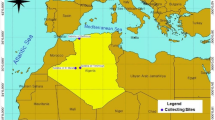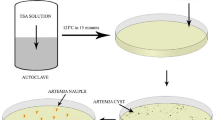Abstract
We studied the effect of pH (pH 5, 6, 7 and 8) on the hatching percentage, survival and reproduction of Artemia strains in Bohai Bay salt ponds. Strains included parthenogenetic Artemia from Bohai Bay (BHB), Artemia franciscana from San Francisco Bay, and A. franciscana artificially produced in salt ponds in Vietnam. The latter was included as a potential inoculum for biological management of salt ponds. The hatching percentage of cysts after 24 h and the survival rate of the tested Artemia strains were significantly reduced when exposed to a culture medium at pH 5 for 18 d (P<0.05). The tolerance of Artemia to 48 h acid exposure varied with developmental stage, increasing in the following order: juvenile, nauplii, pre-adult, with maximum tolerance in adults. All strains of Artemia tested could not reproduce at pH 5. At pH levels from pH 6-8, a higher pH generally resulted in a shorter brood interval and enhanced ovoviviparity. Hence, we suggest that brine acidification has a negative impact on Artemia populations in the Bohai Bay saltworks. Inoculation of Artemia with either local parthenogenetic Artemia or exotic A. franciscana should be feasible at pH 7–8.
Similar content being viewed by others
References
Allan G L, Maguire G B. 1992. Effect of pH and salinity on survival, growth and osmoregulation in Penaeus monodon Fabricus. Aquaculture, 107: 33–47.
Baert P, Nguyen T N A, Quynh V D, Nguyen V H. 1997. Increasing cyst yields in Artemia culture ponds in Vietnam: the multi-cycle system. Aquacult. Res., 28: 809–814.
Browne R A, Davis L E, Sallee S E. 1988. Effects of temperature and relative fitness of sexual and asexual brine shrimp Artemia. J. Exp. Mar. Biol. Ecol., 124: 1–20.
Browne R A, Halanych K M. 1989. Competition between sexual and parthenogenetic Artemia: a re-evaluation (Branchiopoda, Anostraca). Crustaceana, 57: 57–71.
Camara R C. 2001. Dispersal of Artemia franciscana Kellogg (Crustacea: Anostraca) populations in the coastal saltworks of Rio Grande do Norte, northeastern Brazil. Hydrobiologia, 466: 145–148.
Carpenter J F, Hand S C. 1986. Arrestment of carbohydrate metabolism during anaerobic dormancy and aerobic acidosis in Anemia embryos: determination of pH sensitive control point. J. Comp. Physiol., 156B: 451–460.
Chen S M, Chen J C. 2003. Effects of pH on survival, growth, molting and feeding of giant freshwater prawn Macrobrachium rosenbergii. Aquaculture, 218: 613–623.
Conte F P, Geddes M C. 1988. Acid brine shrimp: metabolic strategies in osmotic and ionic adaptation. Hydrobiologia, 158: 191–200.
Dhont J, Sorgeloos P. 2002. Applications of Artemia. In: Abatzopoulos T J, Beardmore J A, Clegg J S, Sorgeloos P eds. Artemia: Basic and Applied Biology. Kluwer Academic Publishers, Belgium. p.251–277.
Doyle J E, McMahon B R. 1995. Effect of acid exposure in the brine shrimp Artemia franciscana during development in seawater. Comp. Biochem. Physiol., 112A: 123–129.
France R L. 1984. Comparative tolerance to low pH of three life stages of the crayfish Orconectes virilis. Can. J. Zool., 62: 2 360–2 363.
Gajardo G M, Beardmore J A. 2012. The brine shrimp Artemia: adapted to critical life conditions. Frontiers in Physiology, 3: 1–8.
Hand S C, Carpenter J F. 1986. pH-induced metabolic transitions in Artemia embryos mediated by a novel hysteretic trehalase. Science, 232: 1 535–1 537.
Hoffman G E, Hand S C. 1990. Arrest of cytochrome-c oxidase synthesis coordinated with catabolic arrest in dormant Artemia salina. J. Exp. Physiol., 258: 1 184–1 191.
Kappas I, Abatzopoulos T J, Nguyen V H, Sorgeloos P, Beardmore J A. 2004. Genetic and reproductive differentiation of Artemia franciscana in a new environment. Mar. Biol., 146: 103–117.
Lenz P H, Browne R A. 1991. Ecology of Artemia. In: Browne R A, Sorgeloos P, Trotman C N A eds. Artemia Biology. CRC Press, USA. p.237–253.
Morgan D O, McMahon B R. 1982. Acid tolerance and effects of sublethal acid exposure on ionoregulation and acidbase status in two crayfish Procambarus clarkii and Orconectes rusticus. J. Exp. Biol., 97: 241–252.
Nguyen T N A, Nguyen V H, Van Stappen G, Sorgeloos P. 2009. Effect of different supplemental feeds on proximate composition and Artemia biomass production in salt ponds. Aquaculture, 286: 217–225.
Nguyen T N A, Nguyen V H, Van Stappen G, Sorgeloos P. 2010. Effect of partial harvesting strategies on Artemia biomass production in Vietnamese salt works. Aquacult. Res., 41: 289–298.
Sorgeloos P, Van Der Wielen C R, Persoone G. 1978. The use of Artemia nauplii for toxicity tests: A critical analysis. Ecotoxicology and Environmental Safety, 2: 249–255.
Sui L Y, Zhang Q, Wang J, He H, Sorgeloos P, Van Stappen G. 2012. High-temperature adapted Artemia franciscana from Vietnam is a suitable strain for inoculation in temperate conditions of Bohai Bay saltworks, China. Crustaceana, 85(14): 1 709–1 723.
Tackaert W, Sorgeloos P. 1991. Biological management to improve Artemia and salt production at Tanggu Saltworks in the P. R. China. Proceeding of International Symposium on Biotechnology of Saltponds, Tanggu, Tianjin, P.R. China, 18–21 September 1990. 283pp.
Tackaert W, Sorgeloos P. 1993. The use of brine shrimp Artemia in biological management of solar saltworks. In: Kakihana H, Hardy H R, Hoshi T, Tkoyokura K eds. Proceeding of 7th International Symposium on Salt, 1: 617–622.
Tackaert W. 1987. Workshop Report: Role of Artemia in solar salt operations. In: Sorgeloos P, Bengtson D A, Decleir W, Jaspers E eds. Artemia Research and Its Applications. Vol. 3. Ecology, Culturing, Use in Aquaculture. Universa Press, Belgium.
Triantaphyllidis G V, Poulopoulou K, Abatzopoulos T J, Perez C A P, Sorgeloos P. 1995. International study on Artemia XLIX. Salinity effect on survival, maturity, growth, biometrics, reproductive and life span characteristics of a bisexual and a parthenogenetic population of Artemia. Hydrobiologia, 302: 215–227.
Van Stappen G, Yu H Y, Wang X M, Hoffman S, Cooreman K, Bossier P, Sorgellos P. 2007. Occurrence of allochthonous Artemia species in the Bohai Bay area, P. R. China, as confirmed by RFLP analysis and laboratory culture tests. Fund. Appl. Limnol., 170: 21–28.
Van Stappen G. 1996. Artemia. In: Lavens P, Sorgeloos P eds. Manual on the Production and Use of Live Food for Aquaculture. FAO Fisheries Technical Paper No 361, FAO Rome. p.101–154.
Van Stappen G. 2002. Zoogeography. In: Abatzopoulos T J, Beardmore J A, Clegg J S, Sorgeloos P eds. Artemia: Basic and Applied Biology. Kluwer Academic Publishers, Belgium. p.171–224.
Vanhaecke P, Siddall S E, Soregeloos P. 1984. International study on Artemia. XXXII. Combined effects of temperature and salinity on the survival of Artemia of various geographical origins. J. Exp. Mar. Biol. Ecol., 80: 259–275.
Wickins J F. 1984. The effect of hypercapnic sea water on growth and mineralization in penaeid prawns. Aquaculture, 41: 37–48.
Zhang B, Guo J C, Shang Z H. 1993. Inoculation of Artemia franciscana in Bohai Bay saltworks, P. R. China. Chinese J. Sea-lake Salt Chem., 22: 7–10. (in Chinese)
Author information
Authors and Affiliations
Corresponding author
Additional information
Supported by the International Cooperation Research Program of the Ministry of Science & Technology of China (No. 2010DFA32300), the Pilot Project for International Cooperation “Aquaculture in Hebei and Shandong Provinces” funded by the Province of East-Flanders, Belgium, and the Nature Science Foundation of Tianjin (No. 13JCZDJC28700)
Rights and permissions
About this article
Cite this article
Sui, L., Deng, Y., Wang, J. et al. Impact of brine acidification on hatchability, survival and reproduction of Artemia parthenogenetica and Artemia franciscana in salt ponds, Bohai Bay, China. Chin. J. Ocean. Limnol. 32, 81–87 (2014). https://doi.org/10.1007/s00343-014-3107-5
Received:
Accepted:
Published:
Issue Date:
DOI: https://doi.org/10.1007/s00343-014-3107-5




